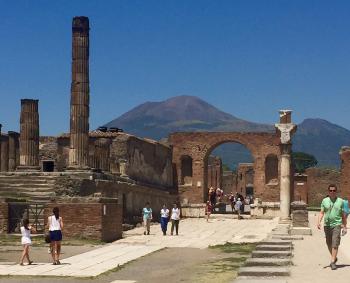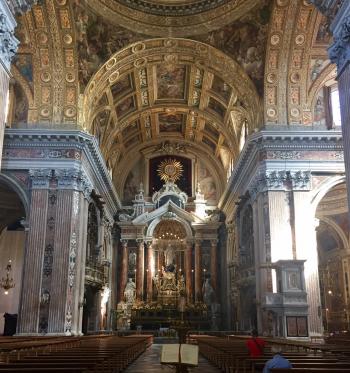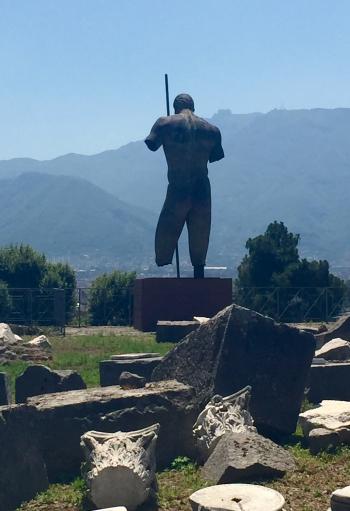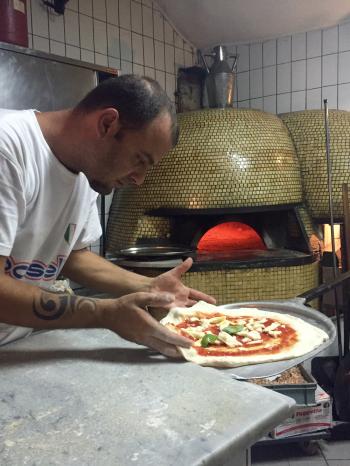Pizza, piazzas and a visit to Pompeii on an independent tour of Naples
This article appears on page 40 of the March 2017 issue.
One of the oldest continually inhabited cities in Europe, Naples is home to many important historical sites and is widely recognized as the pizza capital of Italy, making it a prime target for history buffs and foodies alike. In July 2016, my wife, Maria, and I, along with two “tween” grandchildren, headed to this third-largest Italian city. Our trip would focus on Naples’ historic city center, the largest in Europe, and the famous pizza restaurant it contains.
Getting settled
The history of pizza, as we know it today, is closely tied to the history of Naples.
In the mid-19th century, olive oil and tomatoes were added to a local, inexpensive street dish known as “pizza.” By the end of that century, a pie topped with tomatoes, basil and mozzarella, representing the colors of the Italian flag, was introduced. Named “pizza Margherita” after Margherita of Savoy, the Queen consort of Italy at the time, this was the version that first migrated to the States with the Italian immigrants who came at the dawn of the 20th century and spread from New York, Boston and Philadelphia west to Chicago, St. Louis and, eventually, Los Angeles.
We began our trip with a train ride to Naples from Rome and enjoyed the 3-hour journey through the landscapes of Italy’s southwestern coast.
Arriving at Naples’ central station on Piazza Garibaldi, we were prepared to take a taxi to our hotel, the UNA Hotel Napoli, when we spotted it just across the square. This hotel turned out to be a perfect choice, located just off the historic center in the heart of Naples’ “pizzaland.” We booked two double rooms in advance over the Web (www.unahotels.it) for €120 ($129) per room per night, including a full breakfast buffet.
Hop on, hop off
As we often do when visiting a new city, we spent the following day exploring via a Hop On-Hop Off Bus tour (www.hop-on-hop-off-bus.com). We purchased tickets at the central Piazza Municipio, just across from the Red Route’s city-center starting point. For two adults and two children, the total price was €67.
If you stay on the bus, the 11-stop tour takes about an hour, but the advantage of the hop-on, hop-off option, of course, is to be able to get off and back on as you wish, so we took advantage of that.
We selected five of the stops on the Red Route (Linea Route A) to explore more thoroughly, beginning with Stop Four: the National Archaeological Museum. One of the most important museums of its kind in the world, it contains Greek, Roman and Egyptian antiquities, housed in a former university building constructed in the 18th century.
Huge statues of Hercules, Flora and the “Farnese Bull” dominated the halls, while the Egyptian collection in the basement displayed its close link to Roman civilization. The museum also contained an excellent collection from the ruins of Pompeii.
Admission for the four of us cost €20.
Stop Six, the Capodimonte Museum (Museo e Bosco di Capodimonte), was our next choice. Located on a hill overlooking Naples and providing panoramic views of the city, the museum was originally built as a hunting lodge by King Charles III in 1738. It was soon expanded to become his royal palace, housing the family’s extensive art collection, and today it has evolved into one of the largest museums in Italy.
Its priceless collection of some 25,000 paintings, drawings and prints is classically oriented and includes works by Michelangelo and Raphael.
The main floor’s collection featured paintings from the 13th through 16th centuries by Bellini, Titian, El Greco, Masaccio, Caravaggio and Carracci. On the same floor was the Porcelain Parlour of Maria Amalia, containing thousands of pieces of Capodimonte porcelain.
The second floor featured Neapolitan artists, and the third floor displayed contemporary art, including Andy Warhol’s “Vesuvius.”
Admission for four cost €16.
A few more stops
Our tweens enjoyed Stop Seven, the San Gennaro Catacombs, with its wall mosaics and frescoes dedicated to Naples’ patron saint. The catacombs date from the second century, when they likely held the tombs of a noble family. They were later used as a burial ground for bishops through the 11th century.
The lower level contained the chapel of Saint Agrippino.
Admission for the four of us cost €22; tours departed hourly until 2 p.m.
From the catacombs, we strolled over to the busy and fashionable Piazza Bellini (near Stop Eight) for a quick, late lunch. A hangout for students, this square was originally just outside the city walls, parts of which can still be seen in the piazza.
A block away is the 19th-century Teatro Bellini, one of the most beautiful theaters of its kind in Europe. It is still used for opera and ballet performances.
Stop Nine, our last stop, was the Palazzo Caracciolo, an easy walk away from the Duomo (the Cathedral of San Gennaro), the main church of southern Italy and home of the archbishop. Completed in the early 14th century and refurbished in the 18th century, the cathedral features the impressive, ornate Royal Chapel of the Treasure of San Gennaro, containing first-rate artworks from early Italian and French masters.
Alighting the bus back at the starting point, we headed directly across Piazza Municipio to the massive Castel Nuovo (aka Maschio Angioino), a fortress that dominates Naples’ harbor. Built as a royal palace during the 13th century, it had deteriorated over the years, so there was little left of the original castle interior, but the exterior, dominated by a white marble triumphal arch, was dramatic.
The reconstructed halls, rooms and courts contained an interesting collection of local art and sculpture.
Admission for four cost €15.
Pining for pizza
At the request of our two tween pizza lovers, we spent the following day on a pizza tour. Every Neapolitan seems to have his favorite pizzeria, and many disagree on where the oldest and most authentic ones are, so we hired a pizza specialist guide affiliated with the National Archaeological Museum through Select Italy (phone, in the US, 800/877-1755, selectitaly.com) for a 4-hour walking tour, combining the history of pizza — including three stops for a bite — with a tour of Naples’ historic center.
Developed by the Greeks in the sixth century BC, this historic district is also the center of Naples’ “pizzaland.” From late morning till mid afternoon, our most-knowledgeable guide juxtaposed the outstanding sites, including churches, small art museums, monuments, ancient streets and other landmarks, with our three pizza stops.
Our first pizza stop was the fabled Antica Pizzeria Port’Alba (Via Port’Alba 18; phone 39 081 459713), regarded as the oldest pizzeria in Italy — and, therefore, the world — dating back to the end of the 18th century.
We watched a pizza-making demonstration that finished with what was billed as the world’s oldest operating pizza oven. The resulting pizza Margherita was excellent.
We then had an hour’s walk that featured a stop at the church of Gesù Nuovo (Piazza del Gesù), built in the 15th century as a palace and rebuilt by the Jesuits in the 16th.
The outside was very simple, but, inside, the large main chapel and six side chapels were laden with intricately painted and carved domes, pillars and walls and many religious frescoes. This artistic spectacle was initially overwhelming; it would be best to take in each of the small side chapels slowly, one section at a time.
Our next pizza sampling was “street” pizza, which is sold from restaurant storefronts and independent kiosks. A small, rather thick-crusted piece of pizza was wrapped inside a folded piece of cone-shaped parchment, making it easy to consume while on the go.
As we walked off our second taste of pizza, we passed interesting shops, including a number that specialized in musical instruments and featured many old and unique versions of various string varieties.
Our next cultural stop was at the lovely, 14th-century Santa Chiara Church & Monastery (Via Santa Chiara 49), a peaceful cloister featuring a unique display of stunning tiled columns, arches and benches and 17th-century frescoes. The adjacent museum contained a collection of religious and archaeological relics.
Our last pizza stop was for a more formal lunch at Pizzeria Lombardi (Via Benedetto Croce 59; phone 39 081 552 0780), which dates back to 1892. Lombardi is known for its Neapolitan pies featuring a dark, crisp crust and local buffalo mozzarella cheese drizzled with olive oil.
It was the Lombardi family who first brought pizza to New York City’s Little Italy just before the turn of the 20th century.
After an appetizer of stuffed mushrooms and an excellent pizza accompanied by two glasses of fine local Taurasi red from the hills just outside Naples, we were more than ready to stagger back to our hotel for a siesta.
But we wanted to make one last stop on our way, to see “The Seven Works of Mercy,” the haunting painting commissioned from Michelangelo Merisi da Caravaggio that is displayed among many other Italian sculptural and painted masterpieces in the overwhelming picture gallery of the Pio Monte della Misericordia (Via dei Tribunali 253; phone 39 081 44 69 44), a charity institution founded in 1601 by Neapolitan aristocrats.
Admission for our family cost €14.
While we very much enjoyed our pizza tour, the cost for the four of us (€417) was, in retrospect, way over the top. You could repeat the tour with proper research and a local, knowledgeable guide hired through your hotel for about half the price.
On to Pompeii
For day three, we planned a one-hour trip to the ruins of Pompeii. While Maria and I had been there before, we speculated it would prove awesome for our grandkids, and we were not disappointed.
Not being tour people, we decided to go on our own and rent the recorded headphone guides (€9). We found bus service to and from the ruins with hourly departures from Piazza Garibaldi for €15 per person, but when we mentioned that to the desk staff at the UNA Napoli, they suggested the more-frequent train service that could be accessed just three blocks from our hotel. (The total cost was €27 for the four of us.)
Pompeii was originally occupied by Etruscan, Greek and indigenous people as early as the seventh century BC. By the fourth century BC it had become urbanized, and in the first century AD it was occupied by the Romans and became a Roman colony.
In AD 62 there was a violent earthquake, and reconstruction was well under way when, in AD 79, a sudden eruption of Vesuvius buried Pompeii under ash. Excavations, which started in the 16th century, continue to this day.
The Pompeii ruins are vast, covering more than 150 acres and including houses, osterias, gardens, an amphitheater, a necropolis, barracks, villas, temples, sanctuaries, basilicas, theaters, forums and baths, all divided into nine “regions.”
Highlights for us included the House of the Lararium of Achilles in Region I, which features rich and refined pictorial decorations, many with Italian literary references.
Also in Region I, the Garden of the Fugitives includes the casts of 13 adults and children who were frozen in time when they were asphyxiated by the high temperatures and gases from the eruption.
In Region II, the Amphitheatre, the oldest-surviving amphitheater of the Roman world, could hold up to 20,000 spectators from Pompeii and neighboring towns, This often led to bloody brawls between the locals and visitors from nearby Nocera.
In the same region, the necropolis of Nocera Gate contains burial monuments that date back as far as the first century BC. Many Roman royals and aristocrats had their ashes entombed inside the burial chambers there.
The House of the Silver Wedding, in Region V, is one of the most solemn and majestic examples of an aristocrat’s home. Its many rooms feature impressive architecture, towering columns and fine wall art.
Another favorite site was the Villa of the Mysteries, which derived its name from the tales of mysteries illustrated in the residential part of the building. Cult-art wall paintings depicted scenes of ecstasy-inspired drinking, dancing and ritual flagellation.
In Region VIII, the Forum Granary was used for storing fruits and vegetables and is considered one of the most important of Pompeii’s archaeological spots. It contains over 9,000 artifacts, including pots and pans, jugs, bottles, terracotta crockery and large containers for shipping oils, wine and sauces.
The Temple of Jupiter dominates the north side of the Forum below Mount Vesuvius and features tall statues of Jupiter, Juno and Minerva.
A minor mishap
The following day, we boarded our train back to Rome for our flight home. Unfortunately, when reaching to remove an item from the overhead rack, I bumped my head and soon felt a large bump rising.
There was a stewardess on the train distributing newspapers and drinks, and I asked my wife to ask her for some ice. She sent my wife to the adjacent bar car, where she requested ice in a napkin from the bartender. Her request was overheard by two uniformed train attendants, who returned to our seats carrying a giant first-aid kit containing a squeezable ice pack, which was just what I needed.
The attendants then directed us to fill out a 3-page accident form, written completely in Italian. With help from one of the attendants who spoke a little English, we spent some 20 minutes filling out the complex form.
At the bottom of page three, there were two paragraphs with boxes to check beside each, one apparently absolving the railroad of responsibility for the accident and one not. The attendant’s limited English was confusing, so we accidentally checked the “not absolving” box, and I signed the forms.
One quick look by the attendants and we shortly heard an announcement asking any doctors on board to “come to carriage three.” Three doctors shortly showed up, and one, who spoke English, quickly examined me and explained that we had checked the “not absolving” box and that the train would be stopped at the next city, where the police would escort us by ambulance to the nearest hospital.
We protested and, with the help of an English-speaking passenger, explained our mistake to the attendants and said we had no intention of getting off the train before Rome. They stepped aside, made some phone calls and finally agreed to have me write “void” on and sign each page of the form before filling out a new one, on which I checked the “absolve the railroad from responsibility” paragraph.
We held our breath at the next stop but saw no police or ambulance at the station and proceeded to Rome for our flight home.
Lesson learned — watch your head!




